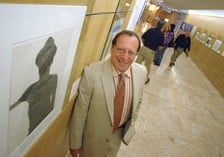Donated works build Art Center’s status

.floatimg-left-hort { float:left; } .floatimg-left-caption-hort { float:left; margin-bottom:10px; width:300px; margin-right:10px; clear:left;} .floatimg-left-vert { float:left; margin-top:10px; margin-right:15px; width:200px;} .floatimg-left-caption-vert { float:left; margin-right:10px; margin-bottom:10px; font-size: 12px; width:200px;} .floatimg-right-hort { float:right; margin-top:10px; margin-left:10px; margin-bottom:10px; width: 300px;} .floatimg-right-caption-hort { float:left; margin-right:10px; margin-bottom:10px; width: 300px; font-size: 12px; } .floatimg-right-vert { float:right; margin-top:10px; margin-left:10px; margin-bottom:10px; width: 200px;} .floatimg-right-caption-vert { float:left; margin-right:10px; margin-bottom:10px; width: 200px; font-size: 12px; } .floatimgright-sidebar { float:right; margin-top:10px; margin-left:10px; margin-bottom:10px; width: 200px; border-top-style: double; border-top-color: black; border-bottom-style: double; border-bottom-color: black;} .floatimgright-sidebar p { line-height: 115%; text-indent: 10px; } .floatimgright-sidebar h4 { font-variant:small-caps; } .pullquote { float:right; margin-top:10px; margin-left:10px; margin-bottom:10px; width: 150px; background: url(http://www.dmbusinessdaily.com/DAILY/editorial/extras/closequote.gif) no-repeat bottom right !important ; line-height: 150%; font-size: 125%; border-top: 1px solid; border-bottom: 1px solid;} .floatvidleft { float:left; margin-bottom:10px; width:325px; margin-right:10px; clear:left;} .floatvidright { float:right; margin-bottom:10px; width:325px; margin-right:10px; clear:left;}
It wasn’t until Stephen Exel joined the Des Moines Art Center Print Club more than seven years ago that he began to understand the value of some of his late-1960s abstract prints. Though he hasn’t donated any prints to the Art Center yet, the Beaverdale resident and club president admits it could be a possibility in the future.
The Print Club is just one way the Des Moines Art Center fosters relationships with art collectors in Greater Des Moines. Its connections have led to an extensive list of donated works, which have helped the Art Center earn the status of a world-class museum.
“Artwork in today’s market is extraordinarily expensive,” said Art Center Director Jeff Fleming, “and most museums are not able to buy at least larger works, because of their cost. So we depend upon gifts to a large extent.”
It’s not uncommon to walk around the Art Center and see under the description of the works a tribute to a donor. Many are names of prominent families in Des Moines, including Melva Bucksbaum and the Bucksbaum family and John and Mary Pappajohn.
Most of its African art collection came in the form of gifts from Irma and Julian Brody, Fleming said, and many of its prestigious works, such as Henri Matisse’s “Woman in White,” given by Elizabeth Bates Cowles and John Cowles, are gifts.
An acquisition committee meets eight times a year to consider donated works or possible purchases. Fleming and the Art Center curator meet beforehand, offering a recommendation on whether to accept a piece.
Often, there is some type of donated work to consider at that meeting, Fleming said. However, not all works are accepted because they might not fit in with the Art Center’s focus on modern contemporary art or fit in with its earlier period works that help show influences on later art.
In its spring newsletter, the Art Center announced several new additions to its permanent collection, many of which came as gifts.
Stacy Polydoran gave three new works to be included in the Paul and Anastasia Polydoran Collection: Anna Gaskell’s “Untitled #75,” Sean Scully’s “Untitled” and Anne Chu’s “Study for a Marionette Man.” Jerry Perry donated 60 photographs by Dmitri Baltermants and Michael Disfarmer in honor of his grandparents, Myron and Jacqueline Blank, adding to major gifts of photographs in 2006 and 2007.
“It’s a wonderful example,” Fleming said. “He doesn’t live in Des Moines, but he obviously has a relationship to Des Moines because of his grandparents and feels a strong connection.”
Funds, such as the Mildred M. Bohen Fund, which helped the Art Center purchase Martin Schongauer’s “Christus Segnet Maria” and Augustin Hirschvogel’s “Courtyard of a Castle,” are also major gifts that help expand the Art Center’s collection.
The Hirschvogel landscape etchings are extremely rare, with only 35 known landscape images by the artist.
Collectors groups – the Print Club and Contemporary Collectors Club – also help the Art Center develop relationships with potential donors.
Both clubs are designed to educate and develop an interest in collecting, but the Print Club is a membership-based organization with paid dues, and the Contemporary Collectors Club is open to anyone who donates $1,000 or more to the Art Center.
“Hopefully we’ve established interest in the community in collecting,” Fleming said, “and fostered that interest and educated that interest and that it is a reciprocal relationship.”
The Print Club has donated 52 works since it began in 1982, including this year’s gift of Paul Cadmus’ etching “Two Boys on a Beach.”
Each year, it commissions an artist to create several works of art that it sells to its members; it uses the funds to buy a print from the Des Moines Art Center’s “wish list” and donate it.
The club also gives one of the commissioned pieces to the museum. This year, 15 members also joined together to raise the funds to donate John Steuart Curry’s lithograph “John Brown.”
Members of the club – currently there are 190 – also have donated well over a thousand works from their own collections through gifts or bequests.
The late historian and feminist Louise Noun donated nearly 160 artworks out of the more than 260 pieces in her collection, and John Huseby, a graphic designer from Ames, gave more than 500 works to the Art Center by gift and bequest, including etchings by 17th-century printmaker Jacques Callot.
Dale Jansen, who sits on the Art Center’s acquisition committee, is a member of the Contemporary Collectors Club and has been a part of the Print Club since it formed.
He has donated a couple of prints to the museum – Jim Dine and Donald Judd pieces – one of which was in honor of the Art Center’s 50th anniversary celebration. Most of his private collection consists of prints, with 80 to 90 pieces mostly from the 1960s.
Jansen, who’s interest in art began with an art appreciation course in college, said he finds these clubs, especially the Print Club, which he’s more involved in, to be “an opportunity to keep learning about the prints, new artists, what’s happening in different print shows.
“So there’s a lot of information out there and I think if you’re going to be a collector, the more you learn, the more you read, the more you expose yourself to it, the more you’re informed about it, doing a good job at it and making the right choices,” he said.
Fleming said this type of relationship with art collectors isn’t unusual for museums.
“It’s a way to develop a closer kind of relationship,” he said, “to educate and solicit around it.
“The history of giving and the reciprocal relationship with the Art Center have been really extraordinary.”








